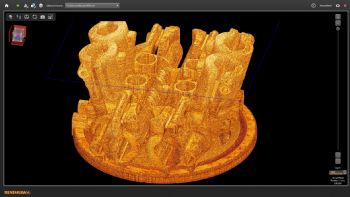
To give additive-manufacturing (AM) users a greater understanding of their processes, Renishaw (
www.renishaw.com) has developed new process-monitoring software — InfiniAM Spectral — for use on its systems.
Laser powder-bed fusion (LPBF) builds components from millions of laser exposures, and the process must be highly accurate to produce a functional part.
However, there are sources of variation that can occur during the build process, and these can produce anomalies that affect the longevity of a part, but real-time spectral monitoring technology allows manufacturers to gather melt-pool data for traceable production and process optimisation.
The software offers two measurement functions in the sensor modules. The first, LaserVIEW, uses a photosensitive diode to measure the intensity of the laser energy.
The second, MeltVIEW, captures emissions from the melt pool in the near-infra-red and infra-red spectral ranges. These two sensor signals can be compared to help identify discrepancies.
MeltVIEW and LaserVIEW stream data across a conventional computer network on a layer-by-layer basis, so manufacturers can analyse process-monitoring data in real time.
As the build progresses, the data is rendered live in 3-D for viewing in InfiniAM Spectral.
Engineers can analyse the data from each sensor to identify any deviations, which may indicate the presence of anomalies that could lead to defects.
Robin Weston, marketing manager at Renishaw’s AM products division, said: “For additive manufacturing to become a truly ubiquitous manufacturing technology, users and practitioners require a deep understanding of the process.
“This software will be hugely beneficial to manufacturers looking to achieve consistent processing with AM.”
When producing the first part in a series, data from LaserVIEW and Melt-VIEW can be compared with existing X-ray or computed tomography data from a known good part.
The manufacturer can use this ‘gold-standard signal data’ and compare it against data from subsequent parts to judge quality and consistency.